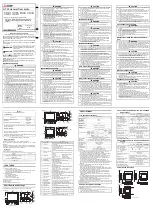
Technology Module TM StepDrive 1x24..48V/5A
MA 1303-A007 EN
70
8.4 Functions of the Integrated Power Stage
It is possible to parameterise both the positioning orders and the technology parameters of
the integrated power stage. These parameterizations are defined once and not with each
traversing job. The parameters of the power unit are transferred in the asynchronous inter-
face of the data record transfer.
Thus, the technology parameters cannot be changed synchronously with the control and
feedback interface, but always while CPU RUN, if no traversing job is available on the TM
StepDrive.
This guarantees that the power stage can be adjusted perfectly for its task before each
traversing job, if it is required by the drive system. For example, you increase the stop cur-
rent when the motor must hold a load and you reduce the current once the system is sta-
tionary without a load in order to minimise power consumption and motor heating. These
parameters are available at any time to get the best out of the TM StepDrive and therefore
of the drive system.
8.4.1 Phase Currents (Run, Stop, Boost Current)
Three different phase currents can be indicated for the TM StepDrive module: run current,
stop current and boost current.
The run current is the one that is produced at a constant velocity (f
RUN
) during the run
mode. After the motor is brought to a stop, we recommend switching to a reduced stop
current after a parameterised Run Current Delay Time (t
DELAY
). This reduces the thermal
losses of the motor at standstill and saves power consumption.
While a stepper motor is accelerated or decelerated, it needs more torque and thus more
power compared to a pure run with a constant velocity (f
RUN
). The torque can then be in-
creased in the phases of acceleration and deceleration.
















































